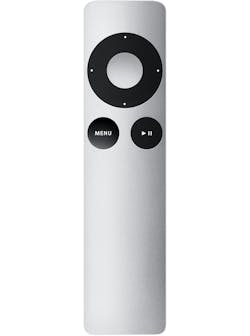“Smarter” IR Preamplifier Features EMI and Optical Robustness
What you’ll learn:
- The non-obvious optical and RF challenges faced by IR-based remote-control links.
- How a new, tailored preamplifier addresses and minimizes these potential problems.
The low-cost, infrared-based remote control has become such a commonplace and accepted part of culture and living that we don’t give it much thought, yet it’s a highly refined and sophisticated device and link. Though non-IR units are available, the IR-based remote is the one that’s included “free” with many devices and appliances.
The concept is simple enough: Modulate a light-emitting diode LED in a handheld, battery-powered unit to trigger a photodetector-based receiver in targets such as video screens, air conditioners, ceiling fans, soundbars, video game systems, set-top boxes, robotic vacuum cleaners, and audio equipment, to cite a few, so that users don’t have to get up from their seat or reach and touch the device being controlled.
The user’s transmit-side unit can have innumerable configurations ranging from minimalist to bewildering (Fig. 1). (If you’re interested in the fascinating and very nonlinear history of IR-based remote controls and their predecessors, see References below.)
This wireless link serves “couch-potato” situations as well as those where actual contact with the unit being controlled would be awkward or impractical. Another significant benefit of using infrared is that as a low-power, non-RF optical link, it operates without need for licensing, has minimal safety concerns, has no regulatory operating-band constraints or restrictions, and brings no RF concerns.
While in use, this unidirectional point-to-point link requires no network configuration or setup. It does one thing, it does it right out of the box, it does it well, it doesn’t interfere with other systems, and it gets out of the way when not in use.
The handheld remote gets much of the link attention, but the receiver side embedded in the product being controlled also merits design effort and conditions. Given the uncountable millions of these units and their maturity, you’d think there would be little room for improvement, but that’s not the case.
Drop-In Enhanced Preamplifiers
Addressing some possible weaknesses at the receiver side, Vishay Intertechnology Inc. upgraded its VSOP383xx series of preamplifier circuits for infrared (IR) remote-control applications in consumer products with the new Cyllene 2 IC. These enhanced devices provide drop-in, plug-and-play replacements for existing devices and feature high ESD-withstand capability to 12 kV.
The new preamplifier ICs counter little-known but legitimate risks to IR-link performance such as DC-rail ripple and fluctuations (many IR-link receivers are powered by the AC line and a DC regulator); steady or varying ambient-light conditions that are a form of optical noise; and, increasingly, RFI from nearby Wi-Fi sources. They offer a wider supply-voltage range from 2.0 to 5.5 V, with 37% higher dark-ambient sensitivity, and improved performance despite nearby Wi-Fi signals and even relatively bright, IR-laden ambient light. Typical current drain is 0.35 mA.
Although termed “preamplifier,” these devices are more than just analog amplifiers for low-level photodetector signals (Fig. 2). They include a narrow bandpass filter for the standard 36-kHz (VSOP38336) and 38-kHz (VSOP38338) carrier frequencies plus an intelligent automatic gain control (AGC) to suppress optical disturbances from sources such as fluorescent lamps and CRTs (yes, they and other “bad guys” are still out there).
The latter factors are growing concerns as remote controls are increasingly used outside while “everywhere” Wi-Fi antennas and devices are widely deployed around the house and office. Susceptibility to EMI from both 2.4- and 5-GHz signals may cause unwanted output pulses, while inconsistent outdoor performance can frustrate users.
As a further benefit to designers, the 2- × 2- × 0.76-mm QFN units are pin-compatible drop-in replacements for existing preamplifier ICs with no mechanical differences and similar electrical characteristics, thus eliminating the need for PCB redesign.
Details are available in the 10-page datasheet that includes full electrical specifications as well as some of the performance graphs you would expect for an analog component such as an amplifier. For those who assume designing an IR link is simple, it is… and is not. Vishay offers some useful tutorials and application notes that can help in this area if needed. They include “Application Overview,” “Data Formats for IR Remote Control,” “Disturbance Sources,” and “General Overview of IR Transmission in Free Ambient.”
References
EE World Online, “The winding path to the infrared remote control: part 1”
EE World Online, “The winding path to the infrared remote control: part 2”
About the Author

Bill Schweber
Contributing Editor
Bill Schweber is an electronics engineer who has written three textbooks on electronic communications systems, as well as hundreds of technical articles, opinion columns, and product features. In past roles, he worked as a technical website manager for multiple topic-specific sites for EE Times, as well as both the Executive Editor and Analog Editor at EDN.
At Analog Devices Inc., Bill was in marketing communications (public relations). As a result, he has been on both sides of the technical PR function, presenting company products, stories, and messages to the media and also as the recipient of these.
Prior to the MarCom role at Analog, Bill was associate editor of their respected technical journal and worked in their product marketing and applications engineering groups. Before those roles, he was at Instron Corp., doing hands-on analog- and power-circuit design and systems integration for materials-testing machine controls.
Bill has an MSEE (Univ. of Mass) and BSEE (Columbia Univ.), is a Registered Professional Engineer, and holds an Advanced Class amateur radio license. He has also planned, written, and presented online courses on a variety of engineering topics, including MOSFET basics, ADC selection, and driving LEDs.



